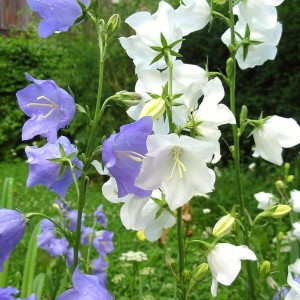The past couple of weeks have seen an explosion of the opulent flowers of late spring—gorgeous, multi-petaled roses, big fluffy peonies, and the complicated, twining blooms of double clematis. The abundance is magnificent, but almost overwhelming.
Now that a couple of downpours have put paid to all those petals, I am refreshed by the simpler shapes that are replacing them. The butter-yellow single flowers of oenothera or four o’clocks; the soon-to-open petals of Shasta daisies; and perhaps most of all, the simple bells of peach-leaf bellflowers, known botanically as Capanula persicifolia.
The perennial plants are part of the huge Campanula genus, which is home to about 300 species, all native to various parts of the northern hemisphere. The common trait is bell-shaped flowers, commemorated in the genus name, which comes from the Latin word “campana”, meaning “bell”. Some churches in my region feature Italian-style “campanile” or bell towers. The root word is the same.
Campanulas range over a large swathe of the world and vary in size from tiny alpine plants to statuesque bloomers like the peach-leaf bellflowers that adorn my garden. Campanula colors are generally shades of blue, blue-purple and white, though some species, like Canterbury bells or Campanula medium, also sport pink flowers.
Peach-leaf bellflower is a willowy specimen, growing anywhere from 18 to 36 inches tall on stiff but slender stems. The plants bear two different sets of leaves. At ground level, a basal rosette of long, bright green leaves anchors each plant. The smaller “peach leaves” grow along the stems. As the name suggests, they are narrow, and ovoid in shape, making early observers think of the leaves of the unrelated Prunus persica or fruit-bearing peach tree.
The leaves are attractive and sometimes evergreen in mild climates, but the flowers are the scene-stealers. Each fat bell is about 1.5 inches long and wide, with individual flowers ranging freely up and down the stems. Unlike other similarly shaped flowers that nod demurely, peach-leaf bellflowers face cheerfully outward.
Sometimes known simply as peach bellflower or willow bellflower, the peach-leaf species is an old-fashioned, “grandmother’s garden” variety. Denise Wyles Adams, in her wonderful book, Restoring American Gardens, mentions that they were first described by colonial American plantsman Bernard M’Mahon in 1806. Since the species is native to northern Europe and Asia, it’s likely that the bellflowers arrived with early colonists and took hold quickly I have seen them naturalized on the sites of old farms in Central New York State. As with lilacs, bellflowers planted by farm families sometimes outlive both the families and the farm buildings.
Breeders have never been as active with peach leaf bellflower as they have with some other campanulas. I like the old variety, ‘Telham Beauty’ that features porcelain blue single bells. ‘New Giant’ is similar, but with even larger blooms. Back in the 1990’s, the renowned English horticultural company, Blooms of Bressingham, applied to patent ‘Chettle Charm’, the offspring of a chance persicifolia seedling found in a garden at Chettle House in Dorset, England. The plants feature single white blooms with blue overtones and narrow blue-purple edges. ‘Chettle Charm’ was a hit in Europe and became popular in North America as well.
To add both lightness and whiteness to your planting scheme, try ‘Takion White’, ‘Alba’, or the more stupendous ‘Alba Superba’.
If you like golden green foliage–which can really lighten up garden spots–you can choose either ‘Blue-Eyed Blonde’ or ‘Kelly’s Gold’, with blue or white single flowers respectively.
Single flowers delight my eye right now, but some people simply can’t get enough doubles. For them, the old varieties ‘’Moorheimii” or ‘Fleur de Neige’, both with double white bells, may fill the bill. Terra Nova Nurseries has also developed ‘Powder Puff’, with even fluffier flowers on somewhat shorter, 26-inch stems.
‘Blue Bloomers” features blue-purple double flowers and ‘Pride of Exmouth’ features darker blue double bells on more compact stems.
It is worth noting that double-flowered varieties seem to be much more popular elsewhere in the world—especially in Europe, New Zealand and Australia, than they are in the United States.
Peach-leaf varieties, especially the singles, spread by self-seeding, as well as by clump expansion. They are not thuggish and I always welcome campanula “volunteers” in the garden. If they pop up in some unwanted place, the seedlings are very easy to move around. All they need is a sunny or very lightly-shaded spot and consistent moisture, and they will go about their business happily with no bother to the gardener. Deadhead spent stalks to encourage reflowering.
Many online and catalog vendors have finished shipping for the spring season, so your best bet for peach-leaf bellflowers is probably a well-stocked local garden center. The most popular online vendors, including Bluestone Perennials and White Flower Farm, may stock single peach-leaf varieties for fall shipping.

